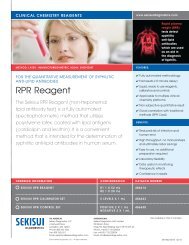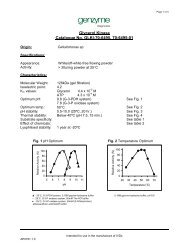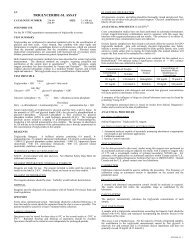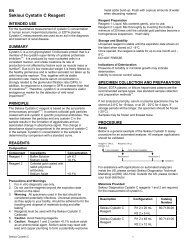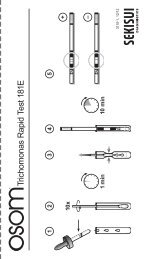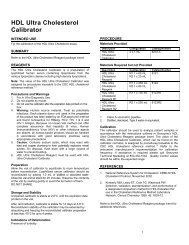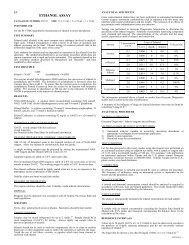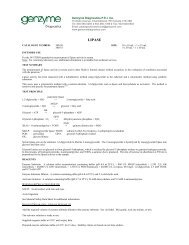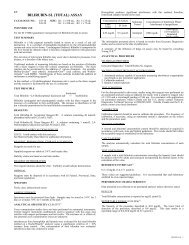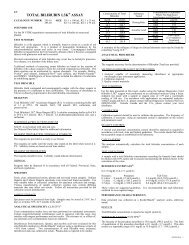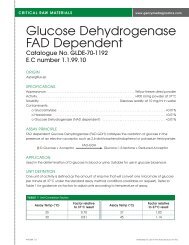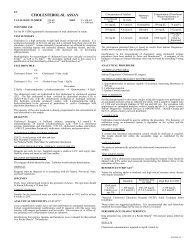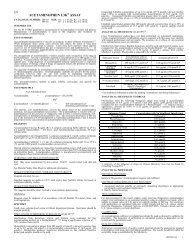CARBON DIOXIDE L3K®-C ASSAY → → - Sekisui Diagnostics
CARBON DIOXIDE L3K®-C ASSAY → → - Sekisui Diagnostics
CARBON DIOXIDE L3K®-C ASSAY → → - Sekisui Diagnostics
You also want an ePaper? Increase the reach of your titles
YUMPU automatically turns print PDFs into web optimized ePapers that Google loves.
ACCURACY (CLSI EP9) (6)The performance of this method (y) was compared with the performance of another carbon dioxidemethod (x) on a Hitachi ® 717 analyzer.Forty-five serum samples ranging from 9.4 to 48.3 mmol/L (mEq/L) were tested and gave a correlationcoefficient of 0.9944. Linear regression analysis gave the following equation:This method = 1.014(reference method) + 0.50 mmol/L (mEq/L).Fifty plasma samples ranging from 9.6 to 46.8 mmol/L (mEq/L) gave correlation coefficient of 0.9907.Linear regression analysis gave the following equation:REFERENCESThis method = 0.973(reference method) + 0.89 mmol/L (mEq/L).1. Tietz, N.W. (Ed.), Fundamentals of Clinical Chemistry, W.B. Saunders Co., Toronto, 636-638, 937(1970).2. Norris, K.A., Atkinson, A.R., Smith, W.G., Clin. Chem. 21 (1975).3. US Patent #5,801,0064. Young, D.S., Effects of Drugs on Clinical Laboratory Tests, AACC Press, Third Edition,Washington (1990).5. Burtis, C.A., Ashwood, E.R.T. (Editors), Tietz Textbook of Clinical Chemistry, 3 rd Edition, W.B.Saunders Company, Philadelphia (1999).6. CLSI Guidelines and Standards, Clinical and Laboratory Standards Institute, Wayne, PA.Definitions for SymbolsThis product fulfills the requirements of the European Directive for InVitro Diagnostic Medical Devices.TRADEMARKSL3K is a registered trademark of <strong>Sekisui</strong>. All other trademarks, brands, product names are the property oftheir respective companies.Authorized Representative:<strong>Sekisui</strong> <strong>Diagnostics</strong> (UK) Limited50 Gibson DriveKings Hill, West MallingKent, ME19 4AFUnited KingdomTel (+44)(0)1732-220022Fax (+44)(0)1732-220024IN28830-8June 7, 2011<strong>CARBON</strong> <strong>DIOXIDE</strong> L3K ® -C <strong>ASSAY</strong>CATALOGUE NUMBER: 288-36 SIZE: 3 x 60 mL288-80 1 x 1000 mLINTENDED USEFor the IN VITRO quantitative measurement of carbon dioxide in human serum and plasma.TEST SUMMARYElevated blood CO2 is almost synonymous with respiratory acidosis. The latter is restricted to clinicalconditions with a primary increase in carbon dioxide in the inspired air or increased metabolic productionof carbon dioxide.Decreased blood CO2 is almost synonymous with respiratory alkalosis. The latter is restricted to clinicalconditions with a primary decrease in carbon dioxide which can result from increased pulmonaryventilation due to mechanical ventilation or stimulation of the respiratory center. (1)Classic techniques for the measurement of carbon dioxide (CO2) involve the addition of acid to liberatethe carbon dioxide and the measurement of carbon dioxide thus released by either manometric,volumetric, or titrimetric techniques. These procedures are both time consuming and cumbersome. The<strong>Sekisui</strong> <strong>Diagnostics</strong>’ Carbon Dioxide L3K ® -C assay is an enzymatic procedure, employingphosphoenolpyruvate carboxylase (PEPC) (2) and a stabilized NADH analog, (3) which is easy to use andapplicable to routine laboratory instrumentation.TEST PRINCIPLEPhosphoenolpyruvate + HCO3 _Oxaloacetate + reduced cofactor + H +PEPC + Mg ++→ oxaloacetate + H2PO4 _MDH→ malate + cofactorPEPC catalyses the first reaction which produces oxaloacetate. In the presence of MDH, the reducedcofactor is oxidized by oxaloacetate. The decrease in concentration of the reduced cofactor is monitoredbetween 405 and 415 nm and is proportional to the total carbon dioxide concentration in the sample.PEPC is specific for the bicarbonate ion (HCO3 _ ) and its action disturbs the following equilibrium whichresults in conversion of the CO2 to HCO3 _ .CO2 + H2O ⇄ H2CO3 ⇄ H + + HCO3 _REAGENTSCarbon Dioxide Reagent: A solution containing buffer (pH 7.5 at 25°C), 63 mmol/L PEP, > 2000 U/LPEPC (microbial), >20 KU/L malate dehydrogenase (mammalian), 3.0 mmol/L NADH analog, activators,stabilizers, a surfactant, and a preservative.WARNINGS & PRECAUTIONS FOR USES24/25: Avoid contact with skin and eyes. See Material Safety Data Sheet for additional information.REAGENT PREPARATION, STORAGE AND STABILITY<strong>Sekisui</strong> <strong>Diagnostics</strong> P.E.I. Inc.70 Watts Avenue, Charlottetown, PE Canada C1E 2B9Tel: 800-565-0265 • 902-566-1396 • Fax: 902-628-6504Email: questions@sekisuidiagnostics.comwww.sekisuidiagnostics.comReagents are ready for use. Supplied reagent stable at 2-8°C until expiry date. Stability claims are basedon real time studies.
REAGENT DETERIORATIONThe reagent solution should be clear. Turbidity would indicate deterioration.DISPOSALReagents must be disposed of in accordance with all Federal, Provincial, State, and local regulations.SPECIMENFreshly drawn serum or plasma are the specimens of choice. Serum or plasma should be separated fromcells immediately and stored at 2-8°C. Exposure of samples to air should be minimized. Samples shouldbe stored tightly sealed to prevent loss of carbon dioxide and assayed as soon as possible after collection.For plasma samples, the anticoagulant, lithium heparin, has been tested and may be used with this assay.SAMPLE STORAGESamples should be stored at 2-8°C.ANALYTICAL SPECIFICITY (CLSI EP7) (6)Cross contamination studies have not been performed on automated instruments. Certain reagent /instrument combinations used in sequence with this assay may interfere with reagent performance and testresults. The existence of, or effects of, any potential cross contamination issues are unknown.Interferences from icterus, lipemia, hemolysis, and ascorbic acid were evaluated for this carbon dioxidemethod on a Hitachi ® 717 analyzer using a significance criterion of >10% variance from control. Datafor plasma is similar to that present for serum.Concentration of AnalyteConventional Units S1 UnitsSubstance TestedConcentration of Interferent WhereInterference is Insignificant30.8 mmol/L 30.8 mEq/L Hemoglobin 1000 mg/dL 155 μmol/L32.8 mmol/L 32.8 mEq/L Ascorbic Acid 3000 µg/dL 170 μmol/L32.9 mmol/L 32.9 mEq/L Bilirubin 40 mg/dL 684 μmol/L30.4 mmol/L 30.4 mEq/L Intralipid 1000 mg/dL3000 mg/dL(33.9 mmol/L)SimulatedTriglyceridesThe information presented above is based on results from <strong>Sekisui</strong> <strong>Diagnostics</strong> studies and is current at thedate of publication.A summary of the influence of drugs on clinical laboratory tests may be found by consulting Young,D.S. (4)ANALYTICAL PROCEDUREMATERIALS PROVIDED<strong>Sekisui</strong> <strong>Diagnostics</strong>’ Carbon Dioxide L3K ® -C Reagent.MATERIALS REQUIRED (BUT NOT PROVIDED)1) Automated analyzer capable of adding a system diluent and capable of accurately measuringabsorbance at appropriate wavelengths as per instrument application.2) Calibration material.3) Quality Control materials.TEST CONDITIONFor the data presented in this insert, studies using this reagent were performed on an automated analyzerusing an endpoint test mode, with a sample to reagent ratio of 1:100, and a wavelength reading of 405 nmor 415 nm. For assistance with applications on automated analyzers within Canada and the U.S., pleasecontact <strong>Sekisui</strong> <strong>Diagnostics</strong> Technical Services at (800)565-0265. Outside Canada and the U.S., pleasecontact your local distributor.CALIBRATIONCalibration material should be used to calibrate the procedure. The frequency of calibration using anautomated system is dependent on the system and the parameters used.QUALITY CONTROLA normal and abnormal concentration control should be analyzed as required in accordance with local,state and federal guidelines. The results should fall within the acceptable range as established by thelaboratory.CALCULATIONSThe analyzer automatically calculates the carbon dioxide concentration of each sample.TEST LIMITATIONSA sample with a carbon dioxide concentration exceeding the linearity limit should be diluted with 0.9%saline and reassayed incorporating the dilution factor in the calculation of the value.REFERENCE INTERVALS22-29 mmol/L (22-29 mEq/L) (5)These values are suggested guidelines. It is recommended that each laboratory establish its own expectedrange.PERFORMANCE CHARACTERISTICSData presented was collected on Hitachi ® 717 analyzer unless otherwise stated.RESULTSCarbon Dioxide concentration is reported as mmol/L (mEq/L).REPORTABLE RANGE (CLSI EP6) (6)The linearity of the procedure described is 50.0 mmol/L (mEq/L). The lower limit of detection of theprocedure described is 1.0 mmol/L (mEq/L). This data results in a reportable range of 1.0-50.0 mmol/L(1.0-50.0 mEq/L).PRECISION STUDIES (CLSI EP5) (6)Precision estimates for serum were obtained using two concentrations of control sera. Plasma basedprecision materials were prepared in-house and spiked to appropriate levels.Total precision was collected on two concentrations of control samples in 40 runs conducted over 20 days.CarbonDioxideConcentrationmmol/L (mEq/L)Total SDTotal CV%Serum 1 13.3 0.6 4.4Serum 2 24.9 1.2 4.6Within run precision data was collected on two concentrations of control samples, each run 20 times in asingle assay.CarbonDioxideConcentrationmmol/L (mEq/L)Within Run SDWithin Run CV%Serum 1 13.3 0.2 1.2Serum 2 24.9 0.3 1.3Plasma 1 14.1 0.2 1.3Plasma 2 22.5 0.4 1.9



